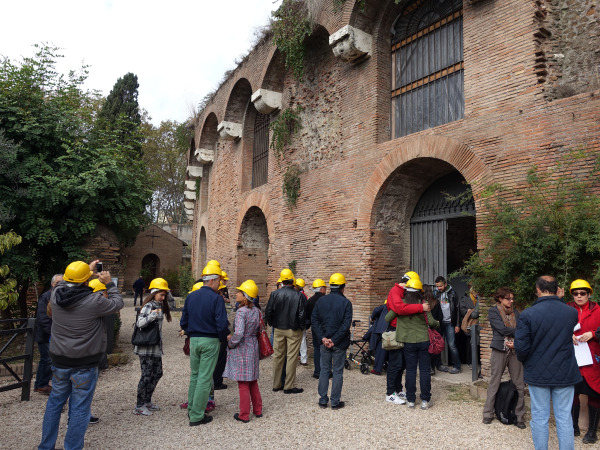
The Domus Aurea is open. These are words rarely heard in the past 1,950 years.
After the great fire of Rome in 64 AD, Emperor Nero rebuilt his Transitory Palace on the Palatine Hill and added the Pleasure Palace on the Oppian Hill we refer to as the ‘Domus Aurea’, the Golden House. The name came from the gold leaf that covered much of the interior. Fragments of these frescos still remain in situ but the gold leaf is all gone.
Nero sold public offices to the highest bidder, raised taxes, devaluated the currency and confiscated property. Anyone convicted of treason would lose their property. Anyone who had property Nero wanted would be convicted of treason. He spared no expense to build his new Palace.
The Domus Aurea was created as a Summer Palace, ingeniously constructed mostly underground to keep it cool. The lighting system used skylights and small holes in the domes that sent shafts of illumination into reflective mirror-like surfaces, filling the rooms with light.
The front façade of the Domus Aurea stretched out over 1,200’ long. There were outdoor gardens, indoor grottos, indoor waterfalls and over 300 rooms all designed for entertainment. There were no sleeping rooms. This was the ultimate Summer Party Pad.
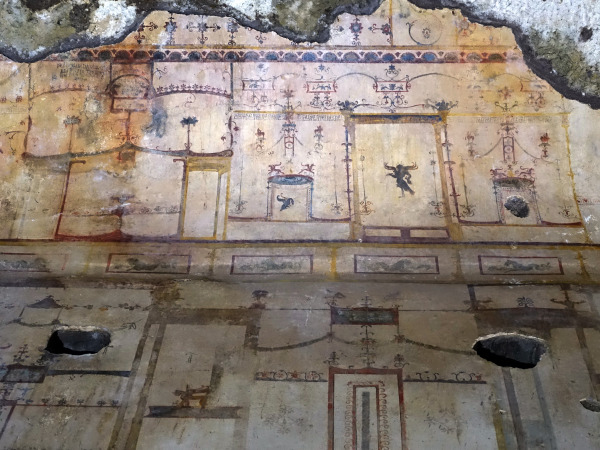
The ceiling decorations were covered frescos, mosaics and gold leaf. A grotto was dedicated to Ulysses, another room was dedicated to Achilles. The octagonal room had a waterfall. The décor was so wonderful, even the head designer’s name was ‘Fabulus’.
Guests were greeted by a 100′ tall idealized nude bronze statue of Nero.
After Nero’s death, the head of the statue was replace with the head of the Sun god ‘Sol Invictus” with rays of the sun extending 23’ long.
The statue, referred to as the ‘Colossus’ during the Middle Ages, gave the name ‘Coliseum’ to the Flavian Amphitheater that was built over the Domus Aurea artificial lake.
In 128 AD, by order of Hadrian, it took 24 elephants to move the statue to it’s new location. You can still see the platform where it once stood near the Coliseum. The original location is now occupied by the bell tower of the Santa Francesca Romana Basilica next to the ancient Forum.
It only took 4 years. When Nero first entered in 68 AD, he was quoted to have said, “at last I can finally live like a human being.” However, the ‘human being’ never got to really enjoy it. The anti-Nero conspirators finally got him in June of 68 AD, a very short time after the Pleasure Palace was completed.
The Roman Senate passed a sentence on him of death by beating. His personal Praetorian Guard shifted their allegiance to Galba, who became the next Roman Emperor, although he lasted only 7 months before being assassinated.
Seeing no way out, Nero decided to take his own life. Unfortunately he could not do it. He had the deed done by his aide, Epaphroditos. Supposedly his last words were “what an artist dies in me”. Nero was 31 years old when he died.
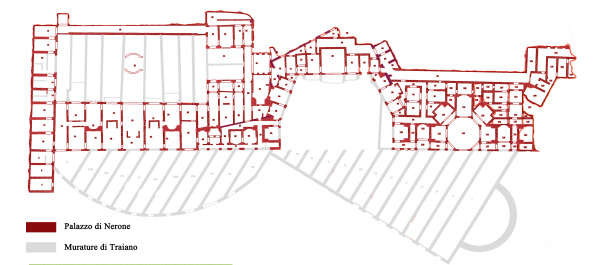 After Nero’s death, most of the Domus Aurea treasures were stripped away. The Palace was left empty for 30 years until the Emperor Trajan filled much of it in with dirt and used it as the foundations for his massive Bath Complex on the Oppian Hill. The diagram to the left shows how the foundations of the Domus Aurea (in red) were incorporated into the Baths of Trajan (in gray). The Baths are above the ground level. Nero’s Domus aurea is below.
After Nero’s death, most of the Domus Aurea treasures were stripped away. The Palace was left empty for 30 years until the Emperor Trajan filled much of it in with dirt and used it as the foundations for his massive Bath Complex on the Oppian Hill. The diagram to the left shows how the foundations of the Domus Aurea (in red) were incorporated into the Baths of Trajan (in gray). The Baths are above the ground level. Nero’s Domus aurea is below.
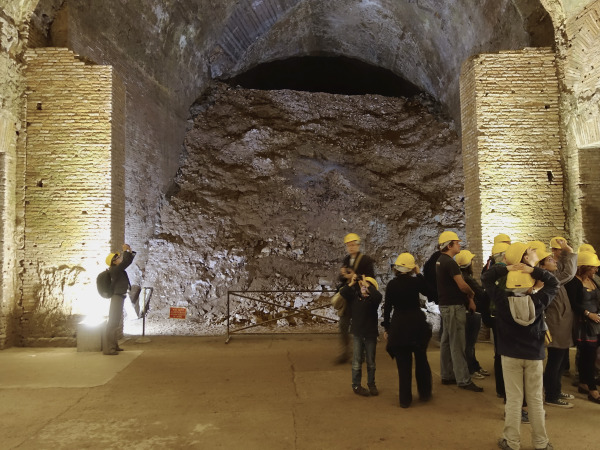
Thanks to the Emperor Trajan that the Domus Aurea is still here. The dirt and debris that filled the halls actually kept them preserved. You can still see some of the halls filled with the dirt levels from the time of Trajan around 105 AD.
The Domus Aurea was just a fabled memory at the end of the 15th century when a young Roman boy fell through a hole in the ground of the Oppian Hill and found himself staring at what became known as grotesque figures, named for the grotto like caverns of the remaining space of the vaulted domes not filled with dirt.
Grotesque style painting, the 3rd and 4th painting style of 1st century Rome, became the ‘in thing’ of the 15th and 16th centuries. You can see the influence they had on Raphael as you look at the Raphael Stanze in the Vatican Museums.
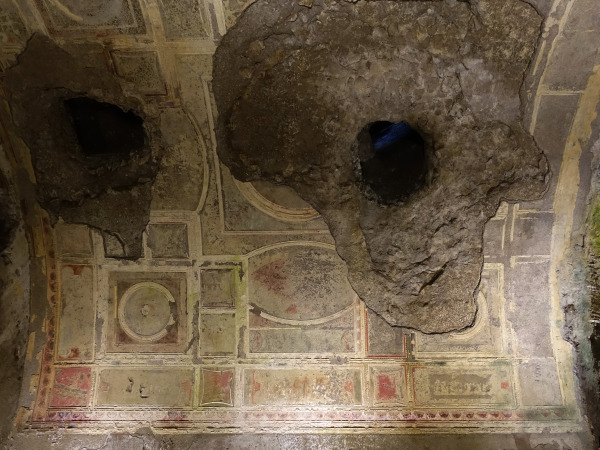
Soon after the re-discovery of the Domus Aurea, artists and curious adventurers dug cave holes through the domes of the palace and crawled along the top of the dirt to see the ancient frescos and sign their names to the walls. Pinturicchio’s name is still visibly scratched into one wall. The holes in the ceilings now look like sores or scars on the once magnificent frescos.
In 1999, the Domus was open to the public. It stayed open for less than six years due to safety concerns of the structure falling in on itself. It closed in 2005. In 2010 a 60 square meter section of one of vaults collapsed.
Over the years, problems have developed between the conservation of the Domus and the park that lives upstairs. The tree roots from the massive trees extend over 12’ and embed themselves into the 1st century concrete domes and the water runoff from heavy rains over the years has destroyed many of the priceless frescos.
The Archeology and Cultural department of Rome, Soprintendenza Speciale Per I Beni Archeologici di Roma, http://archeoroma.beniculturali.it/en has taken on the task of creating a harmonious life between the park and the Domus Aurea. They’ve been restoring the Domus since 2005 and now their project to rehabilitate the park as well by removing the tree roots from the Domus and re-routing the water drainage away from the monument.
Eventually the Oppian Park will have a new landscape with fewer trees and more flower gardens and the soil will have a very ingenious drainage system.
The Archeology and Culture of Rome is using the money from tourism to the Domus to help finish the project. They need 31 million euros and at 10 euros a ticket, it’ll take a while.
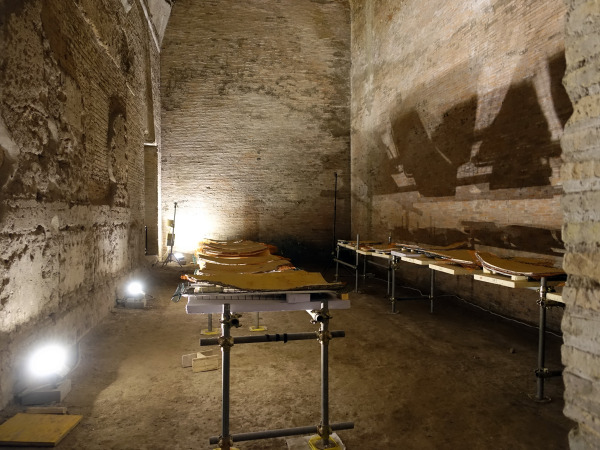
The tours are currently on Saturdays and Sundays, they days when the archeologists are not working. In fact, many of the archeologists who work in the Domus during the week are giving the tours during the weekend. Tours can be interrupted during the rainy season from November through March when the Domus gets flooded from the water seepage of the Oppian park. It is fascinating to visit an ancient site while archeologists and historians are working. Over the years the water damage has been pretty bad and archeologists are removing the fresco plaster from the concrete walls and preserving them in one of the Domus Halls with the intention of putting them back in situ after the water seepage problem has been worked out. Eventually all the fresco art will be restored but this could take many years.
The Domus Aurea is very close to the Coliseum. You can buy tickets at the front gate or if you prefer a guide in English, go to the www.coopculture.it site. The site is also in English and you can buy tickets through the site.
One of the fantastic stories of the Domus Aurea was about the circular revolving dining room (the Coenatio Rotunda). According to the tale, as told by Suetonius,the tongue and cheek biographer of the Caesars, the ceiling rotated by an innovative mechanism cranked by slaves. And as the ceiling turned, perfume was sprayed through small holes and rose petals were dropped on the guests. Legend has it there were so many rose petals falling at one dinner that one of the guests was asphyxiated.
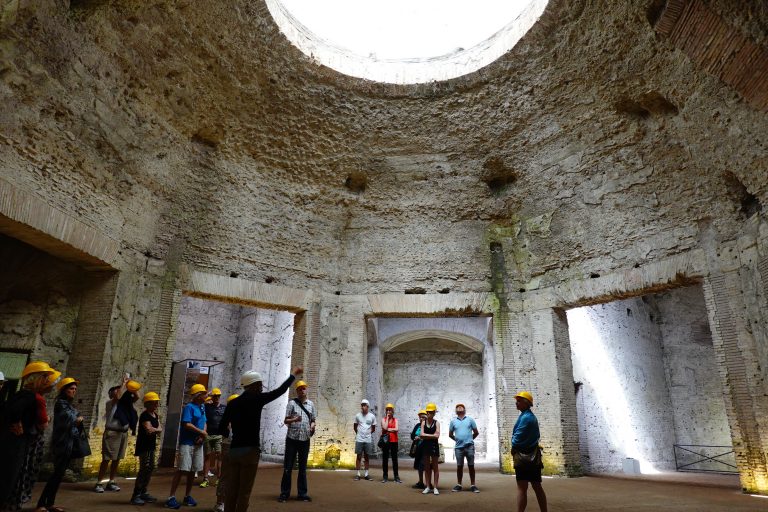
The grand octagonal dining hall of the Domus Aurea (the featured image of this article) was thought to be the location of the fabled rotating hall. There are still the remains of the indoor waterfall and the Oculus to the Oppian Park but any mechanism to rotate the room was never discovered. The rotating room disappeared into Roman Legend until 2009 when the the Vigna Barberini (the old grape vineyards of the Barberini family on the Palatine Hill) opened up after years of excavation. One of the discoveries of the excavation is now considered to be the fabled rotating dining room.
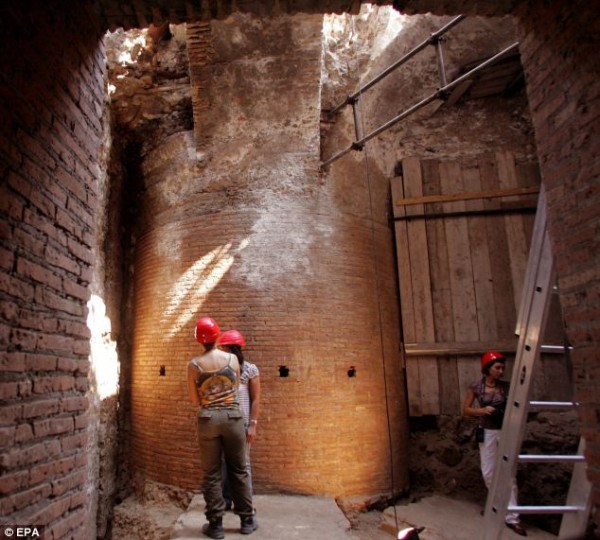
The 16m (53’) diameter room revolved around a 4m (13’) center pillar. At the top of the roof supports the archeologists discovered (5) 25cm (about an inch) holes filled with a dark substance thought to be metal fittings possibly used in the rotation of the ceiling panels. In my photo (see photo link at the end of the page) I was able to see the holes for metal fittings.
This video from the French National Center for Scientific Research (CNRS) gives an excellent understanding of how this amazing rotating dining hall functioned.
The domed ceiling moved around (supposedly) by slaves cranking some kind of rotating mechanism. According the Suetonius, ceiling panels occasionally slid back to allow flower pedals to fall or perfume to spray over the enchanted guests. Nero really knew how to throw a dinner party.
The Domus Aurea Project is ongoing. The archeologists, art historians and art restorers work Monday through Friday. On Saturday and Sunday (during the dry months) these same people lead guided tours through the Domus.
I first wrote this article in 2014. We just went back (2018) to see how how the project was doing.
The gardens in the Parco Oppio are finished in one section. When the gardens and drainage has been completed the restorers will begin the fresco restoration.
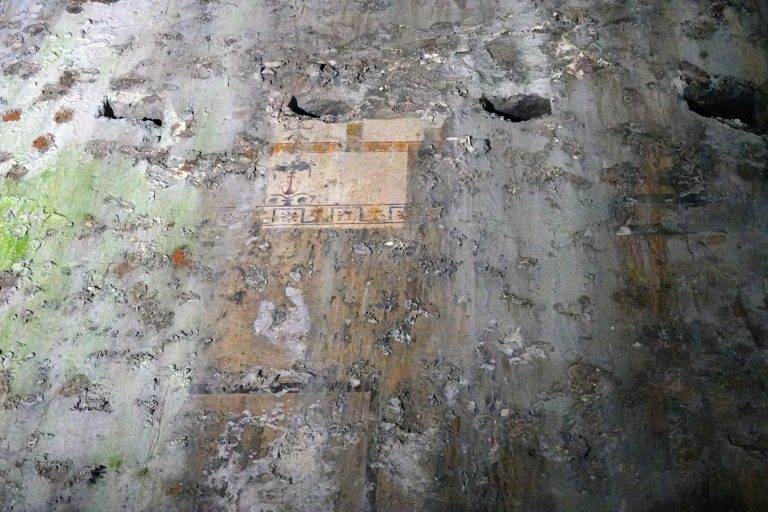
They did a small test (see above) on a wall to see what they will accomplish and it’s very impressive.
The newest additions to the guided tour include a background video on the history of the Domus from it’s conception to completion to transformation to excavation. The video gives a good explanation of how to make sense of the layout.
When Trajan used the Domus Aurea as the foundation for his Bath complex in 104 AD, 36 years after the death of Nero, he sealed off many of the halls and filled others with dirt to give better support to his structure above. Thanks to the dirt, much of the Domus was saved.
In the 2018 tour, the guides have a better understanding of the orientation of the rooms and how they were built off of a large pentagonal courtyard that looked over what is now the Coliseum.
As the tour enters what is now known as the Golden Room because of the ornate decoration of marble and fresco, the guests are invited to put on Virtual Reality headsets. This is one of the most wonderful experiences you could ever have in an ancient site. You actually feel like you are put into the wayback machine and transported to 68 AD.
You must be logged in to post a comment.